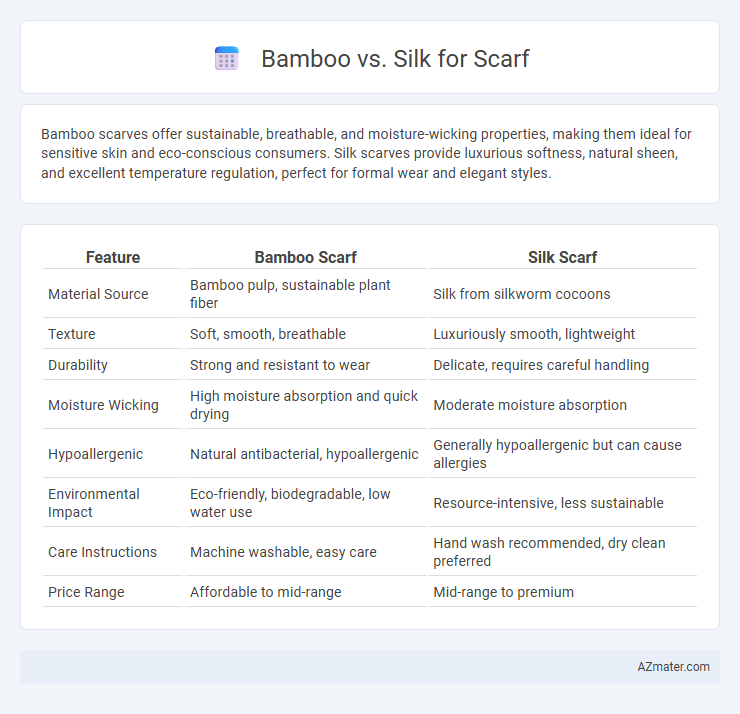Bamboo scarves offer sustainable, breathable, and moisture-wicking properties, making them ideal for sensitive skin and eco-conscious consumers. Silk scarves provide luxurious softness, natural sheen, and excellent temperature regulation, perfect for formal wear and elegant styles.
Table of Comparison
| Feature | Bamboo Scarf | Silk Scarf |
|---|---|---|
| Material Source | Bamboo pulp, sustainable plant fiber | Silk from silkworm cocoons |
| Texture | Soft, smooth, breathable | Luxuriously smooth, lightweight |
| Durability | Strong and resistant to wear | Delicate, requires careful handling |
| Moisture Wicking | High moisture absorption and quick drying | Moderate moisture absorption |
| Hypoallergenic | Natural antibacterial, hypoallergenic | Generally hypoallergenic but can cause allergies |
| Environmental Impact | Eco-friendly, biodegradable, low water use | Resource-intensive, less sustainable |
| Care Instructions | Machine washable, easy care | Hand wash recommended, dry clean preferred |
| Price Range | Affordable to mid-range | Mid-range to premium |
Introduction: Bamboo vs Silk Scarves
Bamboo scarves offer natural moisture-wicking and antibacterial properties, making them ideal for sensitive skin and all-day comfort. Silk scarves, valued for their luxurious texture and vibrant sheen, provide excellent breathability and temperature regulation. Comparing bamboo and silk highlights differences in sustainability, durability, and care requirements crucial for choosing the perfect scarf.
Material Origins: Bamboo and Silk Explained
Bamboo fabric is derived from the cellulose fibers of the bamboo plant, known for its sustainability and natural antimicrobial properties, making it an eco-friendly choice for scarves. Silk originates from the protein fibers produced by silkworms during cocoon formation, renowned for its luxurious texture and smoothness. Both materials offer distinct sensory experiences, with bamboo providing breathability and moisture-wicking benefits, while silk delivers elegance and a soft, lustrous finish.
Texture and Feel: Comparing Softness
Bamboo scarves offer a luxuriously soft texture that feels breathable and smooth against the skin, thanks to the natural fibers that wick moisture effectively. Silk scarves provide a sleek, glossy finish with a lightweight and cool touch, known for their smoothness and subtle sheen. When comparing softness, bamboo tends to be more plush and cozy, while silk is delicate and silky, ideal for a refined, elegant feel.
Breathability and Comfort
Bamboo scarves offer superior breathability due to their natural moisture-wicking properties and porous fiber structure, which keeps the skin dry and cool. Silk scarves, renowned for their smooth texture, provide exceptional comfort but may retain heat slightly more, making them less breathable in warm conditions. Choosing between bamboo and silk depends on preference for lightweight, breathable wear versus luxurious softness and elegance.
Durability and Longevity
Bamboo scarves offer remarkable durability due to their natural fiber strength and resistance to wear, making them ideal for everyday use. Silk scarves, while luxurious and lightweight, require more delicate care to maintain their longevity as the fibers are prone to fraying and damage from friction. Choosing bamboo ensures a longer-lasting scarf with minimal maintenance, whereas silk demands careful handling to preserve its elegant appearance over time.
Eco-Friendliness and Sustainability
Bamboo scarves offer superior eco-friendliness due to bamboo's rapid growth rate and minimal need for pesticides, making it a highly renewable resource compared to silk, which relies on mulberry leaves and significant water consumption. Bamboo produces biodegradable fibers with a lower carbon footprint, while silk production involves energy-intensive harvesting from silkworms, raising sustainability concerns. Choosing bamboo scarves supports sustainable textile practices by reducing environmental impact and promoting resource-efficient manufacturing.
Allergen-Free and Skin Sensitivity
Bamboo scarves are highly regarded for their hypoallergenic properties, making them ideal for individuals with sensitive skin or allergies. Silk, while luxurious and smooth, can sometimes cause irritation or allergic reactions in sensitive users due to natural proteins like sericin. Bamboo's natural antibacterial and moisture-wicking qualities further enhance comfort by reducing skin irritation and allergic flare-ups.
Style and Visual Appeal
Bamboo scarves exhibit a natural sheen and smooth texture that enhances casual and eco-conscious fashion styles while providing excellent color retention for vibrant, lasting patterns. Silk scarves showcase a luxurious luster and fluid drape, elevating formal and elegant outfits with their rich, reflective surface and intricate designs. Both materials offer unique style advantages; bamboo blends sustainability with modern aesthetics, whereas silk delivers timeless sophistication and high visual impact.
Care and Maintenance Tips
Bamboo scarves require gentle washing in cold water with mild detergent to prevent fabric damage and maintain softness, while silk scarves demand even more delicate care, ideally hand-washed or dry cleaned to preserve their sheen and texture. Avoid wringing or twisting both bamboo and silk scarves to prevent fiber distortion, and always air dry flat away from direct sunlight to prevent fading and fiber weakening. Storing these scarves in a cool, dry place with minimal exposure to friction helps extend their lifespan and maintain their luxurious feel.
Price Comparison and Value
Bamboo scarves generally offer a more affordable price point compared to silk, making them a budget-friendly option without sacrificing softness or breathability. Silk scarves tend to be pricier due to their natural fiber production and luxurious texture, but they provide unmatched elegance and durability that can justify the investment. When balancing cost and value, bamboo scarves deliver excellent comfort and sustainability at a lower price, while silk scarves offer long-lasting quality and a refined aesthetic for those willing to invest more.

Infographic: Bamboo vs Silk for Scarf
 azmater.com
azmater.com